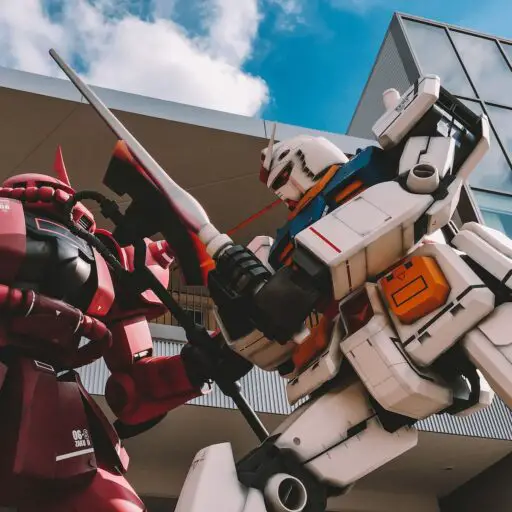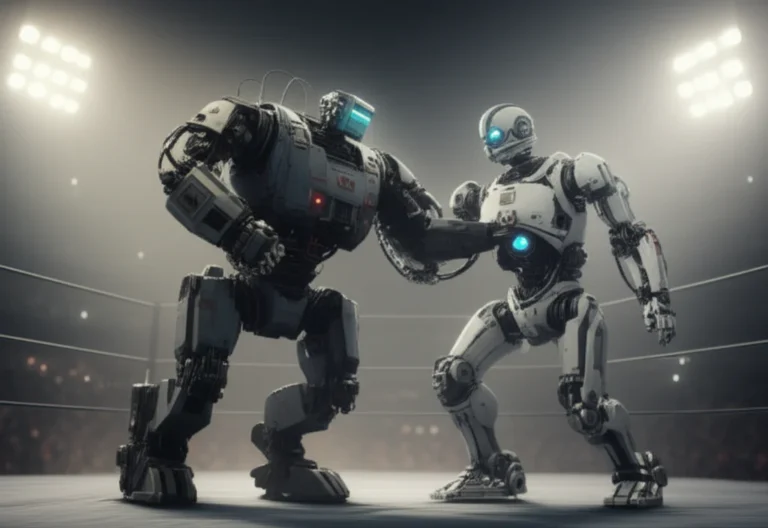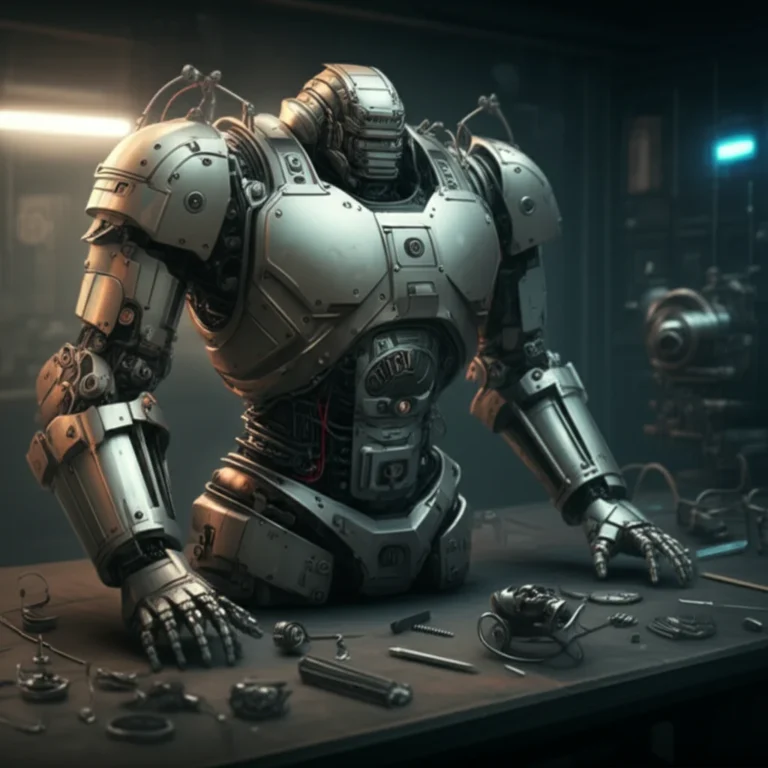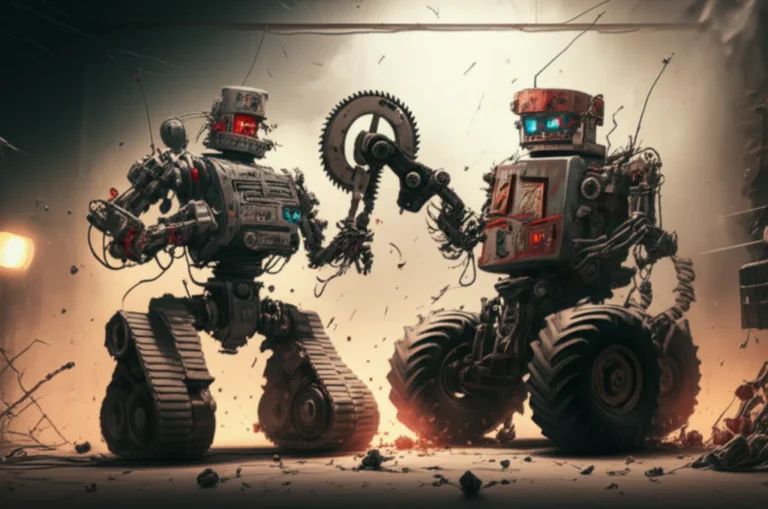Support our educational content for free when you buy through links on our site. Learn more
🤖 6 Popular Robot Designs Dominating Robot Wrestling in 2025
Ever wondered what makes a robot a true wrestling champion? From sleek wedges that bulldoze opponents to jaw-dropping flippers that send rivals flying, robot wrestling is a thrilling blend of engineering genius and strategic combat. In this article, we dive into the six most popular robot designs used in robot wrestling today, uncovering what makes each one tick and how they’ve evolved from simple pushers to high-tech gladiators.
Did you know that some robot wrestlers use powerful magnets to literally stick to the steel ring floor, gaining traction that feels almost like cheating? Or that the fastest bots aren’t always the winners—sometimes, it’s the smartest design that claims victory. Stick around, because later we’ll reveal insider engineering tips from our Robot Wrestling™ experts and share must-watch matches that showcase these designs in action. Whether you’re a budding builder or a die-hard fan, this guide will have you cheering for your favorite bot in no time!
Key Takeaways
- Wedge bots remain the classic, reliable design for pushing opponents out of the ring.
- Flipper bots bring spectacular aerial moves that can instantly end matches.
- Spinner and hammer bots add destructive flair but require precise engineering to control.
- Lifter and grabber bots excel at tactical control and opponent manipulation.
- Hybrid designs combine multiple strategies for versatility and unpredictability.
- Engineering essentials include a low center of gravity, balanced speed and torque, and effective sensor arrays.
Ready to build your own champion? Dive into our detailed tips and resources to start designing your wrestling robot today!
Table of Contents
- 🚀 Quick Tips and Facts About Robot Wrestling Designs
- 🤖 The Evolution of Robot Wrestling: A Design Perspective
- 🎯 1. Top Popular Robot Designs in Robot Wrestling
- 🔧 Engineering Insights: What Makes a Winning Robot Design?
- 🎥 Must-Watch Robot Wrestling Matches Featuring Iconic Designs
- 🛠️ Building Your Own Robot Wrestler: Design Tips and Tricks
- 📊 Comparative Table: Popular Robot Designs and Their Strengths
- 💡 Frequently Asked Questions About Robot Wrestling Designs
- 🎯 Final Thoughts: Choosing the Right Robot Design for Wrestling Glory
- 🔗 Recommended Resources and Links for Robot Wrestling Enthusiasts
- 📚 Reference Links and Further Reading
Here is the main body of the article, written as requested.
🚀 Quick Tips and Facts About Robot Wrestling Designs
Welcome, wrestling fans and robot aficionados, to the ultimate breakdown of robot wrestling designs from your favorite team here at Robot Wrestling™! Before we dive deep into the nuts and bolts, let’s get you warmed up with some rapid-fire facts. Think of this as the pre-match hype reel!
- It’s a Pusher’s World: Unlike the explosive carnage you might see on shows like BattleBots, traditional robot wrestling (often called robot sumo) is about strategy and control. The primary goal? Push your opponent out of the ring, or dohyō, not shred them into a million pieces.
- Weight Matters (A Lot!): Every competition has strict rules, and a big one is weight. To learn more, check out our comprehensive guide on What Are the 6 Weight Classes in the Robot Wrestling League? 🤖 (2025). Knowing your class is the first step to designing a champion.
- Magnets are a Secret Weapon: In many professional leagues, the dohyō is made of steel. This allows clever builders to use powerful magnets on the underside of their bots for insane traction and pushing power. It’s a total game-changer!
- Speed Kills… Traction: While “The Speedster” is a popular archetype, pure speed isn’t everything. A winning design balances speed with torque and control. What good is getting to your opponent first if you just spin your wheels?
- Brains Over Brawn: The sport has evolved from simple remote-controlled machines to fully autonomous gladiators. Today, victory often comes down to superior programming, sensor arrays, and AI that can out-think the opponent.
- Creativity Can Win the Day: “Clever designs often beat pure power.” We’ve seen bots use everything from fast-waving flags to fold-out panels just to confuse an opponent’s sensors.
🤖 The Evolution of Robot Wrestling: A Design Perspective
Ever wonder how we got here, with AI-powered machines battling for supremacy in the ring? The journey of robot wrestling design is a fascinating tale of innovation, passion, and a healthy dose of competitive spirit.
It all started in Japan, inspired by traditional Sumo wrestling. The “granddaddy” of all competitions, the All Japan Robot-Sumo Tournament, was founded way back in 1989 by FUJISOFT Inc. and remains the de facto world championship. In those early days, the designs were simpler, often remote-controlled, and focused on basic pushing power.
As technology advanced, so did the bots. The focus began to shift towards autonomous leagues, which presented a whole new set of engineering challenges. Suddenly, it wasn’t just about the strongest motor or the sharpest wedge; it was about the smartest code. Designers had to figure out:
- How to locate the enemy using sensors.
- How to stay in the ring without a human driver.
This shift sparked a design revolution. We moved from bulky, tank-like robots to sleek, intelligent machines that could react in milliseconds. This evolution is a core focus of our Robot Design category, where we break down the nitty-gritty of what makes modern bots tick. The sport became a “slightly tamer, more academic version” of its destructive cousins, emphasizing brilliant engineering over brute force.
🎯 1. Top Popular Robot Designs in Robot Wrestling
Alright, let’s get to the main event! What are the dominant designs you’ll see battling it out in the Robot Wrestling League? While there are endless variations, most champions fall into one of these powerful archetypes.
⚙️ Wedge Bots: The Classic Pushers
If robot wrestling had a hall of fame, the wedge bot would be the first inductee. It is, without a doubt, the most common and effective design in the sport.
The principle is beautiful in its simplicity: create a robot with a very low, sloped front. The goal is to get this wedge under your opponent, lifting their wheels off the ground and breaking their traction. Once you’ve done that, they’re at your mercy, and pushing them out of the ring is a piece of cake.
- ✅ Strengths: Highly effective, relatively simple to design and build, excellent at controlling the flow of a match.
- ❌ Drawbacks: Can be countered by an even lower wedge. Vulnerable to attack from the sides or rear.
A fantastic example of a platform built for this philosophy is the Pololu Zumo 32U4 Robot, a kit beloved by competitors in the mini-sumo class.
🛡️ Flipper Bots: The Aerial Acrobatics Experts
Who doesn’t love seeing a robot get launched into the air? Flipper bots bring the spectacle! These designs use powerful pneumatic or electric arms to get under an opponent and violently flip them over or, even better, right out of the dohyō.
While pure destruction isn’t the goal, a well-timed flip can completely disable an opponent or end the match in a single, glorious moment. They require incredible engineering to pack so much power into a small frame, but the payoff is huge. They are the true showstoppers of the arena.
- ✅ Strengths: Can win matches instantly, highly entertaining, effective against bots with a high center of gravity.
- ❌ Drawbacks: Complex mechanics can be prone to failure, requires precise timing, a missed flip can leave you exposed.
🔨 Hammer and Axe Bots: The Heavy Hitters
Sometimes, you don’t need to get under your opponent; you just need to bring the pain from above. Hammer and axe bots use a powerful overhead weapon to strike down on their rivals. This design is a close cousin to “The Crusher” archetype, known for its immense power.
In wrestling, the goal of a hammer isn’t necessarily to pierce armor. Instead, it’s used to:
-
Damage critical components like wheels or sensors.
-
Disorient the opponent’s electronics with a powerful shock.
-
Gain leverage by pinning them to the floor for an easy push-out.
-
✅ Strengths: Can inflict targeted damage, effective at disabling opponents without needing to lift them.
-
❌ Drawbacks: The swinging motion can throw off your own bot’s balance, requires a very sturdy chassis to absorb the impact.
🌀 Spinner Bots: The High-Speed Tornadoes
Spinners are the embodiment of kinetic energy. These bots wield a rapidly spinning bar, disc, or shell as their primary weapon. When this spinning mass connects with an opponent, it transfers a massive amount of energy, often sending them flying across the arena.
Spinners are high-risk, high-reward. They take time to spin up to full speed, leaving them vulnerable in the opening seconds. But once they’re going, they are terrifyingly powerful. A solid hit can end the match in a blink. You can see some of the most devastating spinner designs in action by checking out our Competitions coverage.
- ✅ Strengths: Unmatched destructive potential, can win with a single hit, creates a large area of threat.
- ❌ Drawbacks: Vulnerable while spinning up, the powerful gyroscopic forces can make them difficult to control, a big impact can damage the spinner’s own systems.
🦾 Lifter and Grabber Bots: The Tactical Manipulators
Why just push when you can control? Lifter and grabber bots, sometimes called clutching bots, are the strategists of the ring. They use clamps, jaws, or lifting arms to get a firm grip on their opponent.
Once they have a hold, it’s game over. They can calmly lift the other robot, turn, and place them right outside the dohyō. This design requires immense torque and a strong chassis. It’s less about frantic action and more about methodical, undeniable control.
- ✅ Strengths: Supreme control over opponents, less reliant on a single powerful push, can counter aggressive rush bots.
- ❌ Drawbacks: The grabbing mechanism can be a weak point, requires getting very close to the opponent, can be outmaneuvered by faster bots.
⚡ Hybrid Designs: Combining Strength and Agility
The true masters of robot design rarely stick to one archetype. The most dominant bots in the league today are often hybrids, combining the best elements of multiple designs.
Think about a wedge with a powerful lifting arm hidden inside. It can win the ground game and then transition to a control strategy. Or imagine a low-profile spinner that’s difficult to get underneath. These combinations are where the real innovation happens and are a constant topic of discussion in our Behind the Scenes features.
- ✅ Strengths: Versatile, can adapt to different opponents, keeps rivals guessing.
- ❌ Drawbacks: Can be a “jack of all trades, master of none” if not engineered perfectly, increased complexity means more potential points of failure.
🔧 Engineering Insights: What Makes a Winning Robot Design?
So, you know the popular designs. But what’s the secret sauce that turns a good design into a champion? As the saying in the pits goes, “With so many restrictions on size and power, the trick to building a champion robot sumo wrestler lies in design.” Here at Robot Wrestling™, we believe it comes down to four key pillars.
Center of Gravity is King 👑
We cannot stress this enough: prioritize a low center of gravity. We tell every new builder this. As our own internal guide states, “The lower your bot, the harder it is for an opponent to get underneath you.” This is the fundamental principle of the wedge and the first line of defense against almost every other design. Keep your heaviest components—motors, batteries, magnets—as low to the ground as possible.
The Holy Trinity: Weight, Speed, & Torque 💪
A winning robot exists in a perfect balance of these three factors:
- Weight: You want to be as close to the maximum limit for your weight class as possible. Weight provides inertia and pushing power.
- Speed: You need to be fast enough to get to the opponent and react to their movements.
- Torque: This is the rotational force of your motors. High torque is what gives you the raw, unstoppable pushing power to shove an opponent out of the ring.
Finding the right motors and gear ratios to balance these three elements is one of the greatest challenges in robot design.
The Brains of the Operation: Sensors and AI 🧠
For autonomous bots, the “brain” is everything. A typical setup involves:
- Opponent Detection: Using sensors like the HC-SR04 Ultrasonic Sensor to find the enemy.
- Edge Detection: Using downward-facing IR sensors like the TCRT5000 to ensure the bot doesn’t accidentally drive itself out of the ring.
But the best teams get creative, using angled sensors to detect flanking maneuvers or complex arrays to build a full “picture” of the arena.
Traction is Everything जमीन
Your power is useless if your wheels are just spinning. Traction is the key to transferring motor power into pushing force.
- ✅ Good: High-grip rubber tires.
- ✅ Better: Using rubber bands, sometimes secured with hot glue, over your wheels for extra grip.
- ✅ Best: Powerful neodymium magnets on a steel dohyō. The downforce they create provides an incredible, almost unbelievable, amount of traction. Some designers have even experimented with vacuum suction to stick the robot to the mat!
🎥 Must-Watch Robot Wrestling Matches Featuring Iconic Designs
Talk is cheap! You need to see these designs in action to truly appreciate their genius. We’re constantly posting new fights in our Event Announcements, but here are a couple of all-time classics.
One of the best places to see top-tier Japanese robot wrestling is the Robot Pro-Wrestling Dekinnoka! YouTube channel, which boasts over 70.5K subscribers. A standout match that every fan should watch is “SAAGA vs. METALLIC FIGHTER.”
- Event: Robot Pro-Wrestling Dekinnoka! 46
- Date: November 3, 2022
- Significance: This was a Kanto title unification bout, and the video has over 42,000 views.
Watching this match, you can see the clash of design philosophies in real-time. The tension, the strategy, the split-second maneuvers—it’s what this sport is all about!
🛠️ Building Your Own Robot Wrestler: Design Tips and Tricks
Feeling inspired? Ready to throw your hat in the ring? Awesome! Building your first bot is an incredibly rewarding experience. Here’s a quick guide and some product recommendations from our engineering team to get you started.
Essential Tools and Supplies
You don’t need a multi-million dollar workshop, but a few key tools will make your life much easier.
- 3D Printer: Absolutely essential for creating custom chassis and parts. A great starter option is a Creality Ender 3.
- Soldering Iron: For making secure electrical connections.
- Core Electronics: You’ll need a microcontroller (like the Arduino Nano), a motor driver, sensors, and motors.
Recommended Starter Kit: Pololu Zumo 32U4 Robot
If you’re looking for an all-in-one solution, we can’t recommend the Pololu Zumo 32U4 Robot enough. It’s a fantastic, well-documented kit designed specifically for mini-sumo competitions.
| Feature | Our Rating (1-10) |
|---|---|
| Ease of Assembly | 8/10 |
| Combat Performance | 9/10 |
| Programming/Expandability | 10/10 |
| Documentation | 9/10 |
| Overall | 9/10 |
The Zumo comes with an integrated Arduino-compatible microcontroller, motors, drivers, and a basic sensor array. It’s the perfect platform to learn the fundamentals of both building and programming. It does require a little soldering, but that’s a great skill to learn! For more of our thoughts on starter gear, check out our Opinion Pieces.
👉 Shop our recommended gear:
- Pololu Zumo 32U4 Robot Kit: Amazon | Pololu Official Website
- Creality Ender 3 3D Printer: Amazon | Walmart | Creality Official Website
- Arduino Nano: Amazon | Arduino Official Website
📊 Comparative Table: Popular Robot Designs and Their Strengths
Need a quick reference guide? We’ve got you covered. Here’s a table breaking down the key characteristics of the most popular robot wrestling designs.
| Design Type | Primary Goal | Key Strengths | Common Weaknesses | Example Bot/Kit |
|---|---|---|---|---|
| Wedge Bot | Push / Leverage | Simple, effective, great control | Can be out-wedged, vulnerable flanks | Pololu Zumo 32U4 |
| Flipper Bot | Eject / Disable | Instant win potential, crowd-pleaser | Complex, long reload time, exposed when firing | N/A (Often custom builds) |
| Hammer/Axe Bot | Damage / Pin | Targets specific parts, good for control | Can unbalance itself, requires sturdy build | N/A (Often custom builds) |
| Spinner Bot | Eject / Damage | Massive kinetic energy, intimidating | Vulnerable while spinning up, hard to drive | N/A (Often custom builds) |
| Lifter/Grabber | Control / Eject | Total opponent control, methodical | Slower, requires getting close, mechanism is a target | N/A (Often custom builds) |
💡 Frequently Asked Questions About Robot Wrestling Designs
We get a ton of questions from aspiring builders and fans. Here are answers to some of the most common ones.
What’s the most effective robot design for a beginner?
Hands down, the wedge. It teaches you the most important fundamentals of robot wrestling: center of gravity, traction, and the importance of the ground game. It’s simple to design, effective in competition, and provides a great platform to build upon later.
How much does it cost to build a wrestling robot?
The cost can vary wildly. You can build a very basic, small robot for a few hundred dollars. For a highly competitive, custom-designed machine in a heavier weight class, you could be looking at several thousand dollars in parts, materials, and electronics.
Is robot wrestling just about pushing?
No, but it is the primary objective in sumo-style competitions! “Robot wrestling is a thrilling sport where robots battle it out in the ring, showcasing their strength, agility, and design prowess.” While pushing an opponent out of the dohyō is the main way to score points, designs that flip, control, or strategically damage opponents are all valid and effective ways to achieve that goal.
What’s the main difference between Robot Wrestling and BattleBots?
The simplest answer is the objective. As we’ve mentioned, robot wrestling is about pushing and control, not destruction. BattleBots and similar combat robotics events are designed for maximum carnage, with weapons intended to destroy the opponent. Think of it as the difference between Sumo wrestling and a no-holds-barred cage fight. Both are awesome, but they are fundamentally different sports with different design philosophies.
🎯 Final Thoughts: Choosing the Right Robot Design for Wrestling Glory
After exploring the thrilling world of robot wrestling designs, from the humble yet mighty wedge bots to the spectacular flippers and devastating spinners, one thing is clear: there’s no one-size-fits-all champion design. The best robot wrestling design is the one that perfectly balances your engineering skills, strategic vision, and the unique challenges of your weight class.
If you’re a beginner, starting with a wedge bot—like the highly recommended Pololu Zumo 32U4 Robot kit—is a smart move. It teaches the fundamentals of traction, center of gravity, and pushing power, while offering plenty of room to customize and upgrade as you grow.
For the more adventurous, hybrid designs that combine speed, control, and power offer exciting opportunities to outwit and outmaneuver your opponents. Remember, robot wrestling is as much about brains as brawn—the smartest bots often win.
And what about those unanswered questions? Like how to master the perfect balance of speed and torque, or how to engineer a flipper that never misses? Those are the challenges that keep the sport evolving and the community buzzing. Keep experimenting, learning, and watching epic matches like SAAGA vs. METALLIC FIGHTER to see these principles in action.
In short: design boldly, build smart, and never underestimate the power of creativity and strategy in the ring. Your champion bot awaits!
🔗 Recommended Links and Shopping for Robot Wrestling Enthusiasts
Ready to build or upgrade your robot wrestling champion? Here are some top picks and resources to get you started:
-
Pololu Zumo 32U4 Robot Kit:
Amazon | Pololu Official Website -
Creality Ender 3 3D Printer:
Amazon | Walmart | Creality Official Website -
Arduino Nano Microcontroller:
Amazon | Arduino Official Website -
HC-SR04 Ultrasonic Sensor:
Amazon -
TCRT5000 IR Reflective Sensor:
Amazon -
Recommended Reading:
Robot Builder’s Bonanza by Gordon McComb — a classic guide packed with practical tips and insights for building combat and wrestling robots.
Amazon Link
💡 Frequently Asked Questions About Robot Wrestling Designs
What materials are commonly used in building robot wrestling designs?
Materials selection is crucial for balancing durability, weight, and cost. Common materials include:
- Aluminum: Lightweight and strong, aluminum is a favorite for chassis and structural components.
- Steel: Used for armor and parts requiring high strength, though heavier.
- Carbon Fiber: Offers excellent strength-to-weight ratio but is more expensive.
- Plastics (ABS, PLA): Often used in 3D printing parts; PLA is beginner-friendly but less durable, while ABS is tougher.
- Rubber: For wheels and traction-enhancing components.
Choosing the right material depends on your design goals and weight class restrictions.
How do robot designs affect performance in robot wrestling matches?
Design impacts every aspect of performance:
- Center of Gravity: A low center of gravity improves stability and resistance to flipping.
- Shape: Wedges can get under opponents; spinners rely on rotational mass.
- Traction: Materials and wheel design affect pushing power.
- Sensor Placement: Critical for autonomous bots to detect opponents and ring boundaries.
- Weaponry: Flippers, hammers, and spinners add offensive capabilities but increase complexity.
A well-optimized design maximizes pushing power, maneuverability, and durability.
What are the top strategies for designing competitive robot wrestlers?
- Balance Speed and Torque: Fast bots can outmaneuver but need torque to push.
- Optimize Weight Distribution: Keep heavy components low and centered.
- Use Effective Sensors: Combine ultrasonic and IR sensors for opponent and edge detection.
- Plan for Reliability: Avoid overly complex mechanisms that can fail mid-match.
- Test and Iterate: Use practice arenas to refine programming and mechanics.
Which robot designs have won the most battles in the Robot Wrestling League?
Historically, wedge bots dominate due to their simplicity and effectiveness. However, flipper bots and spinner bots have also claimed many victories, especially in higher weight classes where power and complexity are feasible. Hybrid designs are increasingly common among top-tier competitors.
How do weight and size influence robot wrestling design choices?
Weight classes impose strict limits, forcing designers to prioritize:
- Compactness: Smaller bots can be faster and harder to flip.
- Weight Efficiency: Using materials and components that maximize strength without excess mass.
- Power-to-Weight Ratio: Ensuring motors and batteries provide enough force within the weight budget.
Designs must be tailored to the class to avoid being outmatched by heavier or faster opponents.
What role do weapons and armor play in robot wrestling designs?
Unlike destructive combat robotics, robot wrestling focuses on pushing and control, so:
- Weapons like flippers or hammers serve to disable or reposition opponents rather than destroy.
- Armor protects vital components but must be balanced against weight limits.
- Some leagues restrict active weapons, emphasizing pushing and control tactics.
How can beginners start designing robots for robot wrestling competitions?
- Start Small: Use kits like the Pololu Zumo 32U4 to learn basics.
- Learn Programming: Familiarize yourself with Arduino or Scratch-based platforms like mBlock.
- Build a Simple Wedge Bot: Focus on traction, low center of gravity, and sensor basics.
- Join Communities: Engage with forums, local clubs, and online resources.
- Practice: Build a DIY ring and test your bot’s behavior regularly.
📚 Reference Links and Further Reading
- Robot Wrestling™ Official Site — For the latest news, designs, and competitions.
- Pololu Zumo 32U4 Robot Kit — Official product page.
- Creality 3D Printers — Trusted 3D printing solutions.
- Arduino Nano — Microcontroller details.
- Robot Pro-Wrestling Dekinnoka! YouTube Channel — Top-tier robot wrestling matches.
- ABC News: Wrestling Robots Face Off — Insightful coverage of robot sumo wrestling.
- Robot Fighting League — Additional info on robot wrestling competitions and designs.
Ready to build your own champion? Dive into our Robot Design articles and join the thrilling world of Robot Wrestling™!





